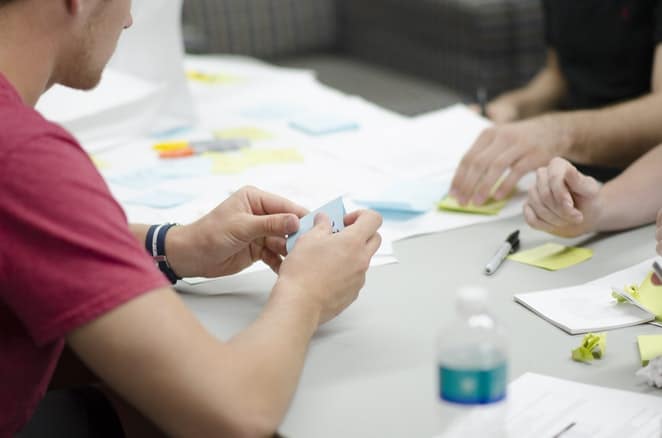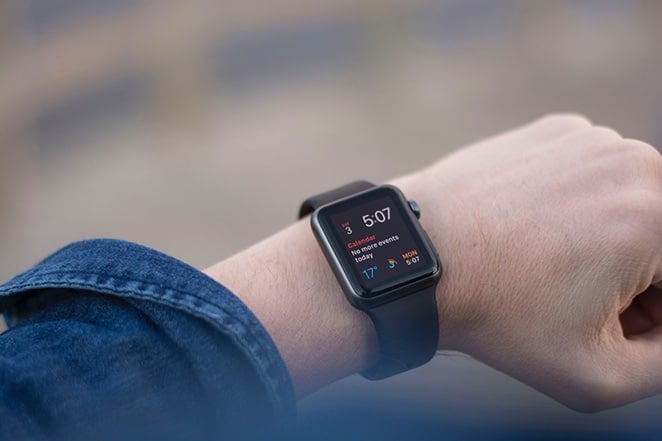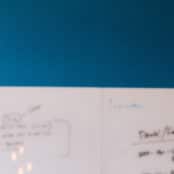
Anybody who works in a creative industry knows only too well that creativity flourishes on flexibility. Creative teams blossom when they have the freedom to play, experiment, and explore new ideas. To push boundaries and test the limits.
This can cause a headache for project managers of creative teams, whose job it is to keep a project on schedule and to budget. So how can you maintain the structure and organization of a creative project without smothering the creativity and productivity of your team?

“Here are nine tips for successfully managing a creative project. ”
1. Draw up a project plan
Planning is an integral element of any project, so resist the urge to dive right in as soon as you receive a new brief. By correctly managing the planning and research stage, you’ll be much better equipped to keep the project on schedule, to budget, and produce your best work for the client.
Draw up a plan in consultation with your client, determining the details during your initial meetings, and sign off on the agreed plan together.
Your plan should include an overview of the project, such as the project aims and objectives, how you’re going to tackle it, the needs of the target audience, and the key milestones, which will help you to draw up a realistic timeline. Include the defined roles and responsibilities of everybody involved, the project budget, and set out the agreed communication methods.
Remember, aspects of a creative project are likely to change as you progress, but this will give you a great foundation as you get started.
2. Use a project management tool
Email is a great tool but it can get a little unwieldy, especially when you have a large team. Did you copy the right people in? Does everybody have access to the same information? Did you remember to pass on the latest updates? And on the flip side, there’s little more annoying than an increasing chain of unnecessary “reply all.”
Leaving people in the dark about an important decision or the project status can cause critical hold ups, which in turn can lead to annoyed clients. The best way to overcome this is to use a project management tool.
Project management tools are excellent. They enable you to create task lists, assign tasks to different team members, set deadlines, and keep an eye on progress. Plus, all the important documents are in the same place, on the same update. Many tools also allow you to invite the client into the fray so they can keep an eye on progress, too.
There are various tools, each with different benefits. Some of my favorites are detailed in this article.
3. Set realistic deadlines

Creating a realistic timeline for the project can be a headache, especially if the client wants everything yesterday! While keeping clients happy is our aim, simply agreeing to their demands to keep them on our side will only end in tears.
Creativity can be a tricky thing to tease out, and creative teams need time to play, sketch out designs, and brainstorm ideas. Instead of forcing teams to meet a tight deadline—the best way to stifle creativity—explain to your client how the creative process works and only agree to a deadline that’s possible. If your client has a rush project with a non-negotiable deadline, be realistic about what you can achieve during that time.
4. Communicate regularly
Regular communication is key to any creative project. Don’t leave it up to your team members to chase deadlines and verify information—use your project management tool to keep everybody updated on progress, notified about any problems or issues, and informed about any updates.
The same goes for your client. If you disappear after you’ve agreed to the project plan and only reappear once the work is completed, they may discover at a critical late stage that the project wasn’t quite what they had in mind.
5. Regularly monitor and review
Remember that big ole plan you agreed to at the start? Ensure you refer back to it regularly throughout the project to check everything is running as planned.
Things inevitably change as you progress, so ensure you stay flexible and adapt accordingly. Record any changes in an updated plan and agree them with your client. That way they won’t have any nasty surprises when you charge for the additional work they requested.
If they add a chunk of work to the project, make sure you have the available resources to deal with it efficiently.
6. Resolve any issues promptly

Projects can run into trouble. Your client may not be happy with an aspect of the work, one of your team may make a costly mistake, or something could work out more time-consuming than expected, pushing things drastically over budget.
If you do meet a hitch, don’t try to cover it up. Honesty is always the best policy, even if it means a difficult conversation or two.
Where possible, try to meet your client in person to talk over any issues face-to-face. Explain any decisions you’ve made, discuss any problems they have, and remember not to take it personally if they don’t like something. Be open and receptive and determine the actions you can take to reach a solution that works for everybody.
7. Be flexible with working hours and environment
Everybody has their own sweet spot when it comes to creativity. Some like to rise at dawn and let their creative juices flow before anybody else is up, while others produce their best work in the dead of the night. One thing’s for sure: creativity doesn’t fit into a regular 9-to-5 schedule.
To get around this, when possible, give your team the flexibility to work at the time that’s best for them by assigning them the work they need to complete rather than dictate the hours you want them to work. This is likely to improve the quality of their work, and you can always stay updated via those useful project management tools!
The same goes for working environment. Some people flourish bouncing ideas off each other in an office, others like to hide away in their own private space, while some like the buzz and anonymity of working in a coffee shop. Giving people the freedom to choose the environment that’s best for them can have outstanding results.
8. Encourage constructive feedback
If you want to produce a design masterpiece, you have to invite constructive feedback. All members of your team should feel confident about expressing their honest opinion about the design. If they worry about upsetting somebody’s feelings or feel their opinion isn’t important, you could end up missing something crucial and morale in the team will fall if people don’t feel their input is worthy.
Likewise, remember to ask the client what they think at important stages of the project. This allows you to identify any possible issues and rectify them before they become too costly and unwieldy to untangle.
Successful feedback is about respecting others’ opinions and openly discussing what is and isn’t working. Who knows, that discussion could spark a brainstorming session that results in a genius idea!

9. Provide a little extra support
Finally, once you’ve signed off the project and handed it over to your client, don’t simply send a final invoice and walk away. Be there to offer support, see if there are any issues that need ironing out, and check the client is happy.
A few weeks down the line, follow up with a call or email to see how things are going and if they need anything else from you. Delivering a great project and showing that you care about their needs is an excellent way to encourage repeat business.
Do you have any tips for managing a creative project? Can you add anything to our list? Tell us in the comments below.







Comments ( 291 )
Josephner
May 28, 2025
ed treatment online: cheap ed medication - Ero Pharm Fast
CurtisAdurl
May 28, 2025
Online medication store Australia: online pharmacy australia - Online drugstore Australia
Josephner
May 28, 2025
pharmacy online australia: PharmAu24 - Pharm Au24
Josephner
May 28, 2025
Ero Pharm Fast: Ero Pharm Fast - Ero Pharm Fast
CurtisAdurl
May 28, 2025
PharmAu24: Discount pharmacy Australia - online pharmacy australia
Josephner
May 28, 2025
Over the counter antibiotics pills: buy antibiotics online - Over the counter antibiotics pills
Josephner
May 27, 2025
п»їed pills online: Ero Pharm Fast - Ero Pharm Fast
Rodneysog
May 27, 2025
Over the counter antibiotics for infection [url=https://biotpharm.shop/#]Biot Pharm[/url] cheapest antibiotics
Josephner
May 27, 2025
get antibiotics without seeing a doctor: BiotPharm - buy antibiotics over the counter
CurtisAdurl
May 27, 2025
online pharmacy australia: Licensed online pharmacy AU - Discount pharmacy Australia
Rodneysog
May 27, 2025
Ero Pharm Fast [url=https://eropharmfast.com/#]Ero Pharm Fast[/url] Ero Pharm Fast
Josephner
May 27, 2025
Licensed online pharmacy AU: Pharm Au 24 - Online medication store Australia
CurtisAdurl
May 27, 2025
PharmAu24: Pharm Au 24 - Pharm Au24
Charlesmub
May 27, 2025
buy antibiotics: buy antibiotics online - buy antibiotics
Rodneysog
May 27, 2025
Online medication store Australia [url=https://pharmau24.com/#]Pharm Au 24[/url] Medications online Australia
CurtisAdurl
May 27, 2025
buy antibiotics from india: buy antibiotics online - over the counter antibiotics
Lorenhag
May 24, 2025
cialis online paypal: Tadal Access - tadalafil prescribing information
FrankieLar
May 23, 2025
https://tadalaccess.com/# order cialis canada
Lorenhag
May 23, 2025
difference between cialis and tadalafil: TadalAccess - buy cialis tadalafil
JosephTes
May 23, 2025
tadalafil brand name [url=https://tadalaccess.com/#]TadalAccess[/url] cialis from canada to usa
FrankieLar
May 23, 2025
https://tadalaccess.com/# cialis price walmart
JosephTes
May 23, 2025
cialis canada [url=https://tadalaccess.com/#]cialis canada over the counter[/url] buy cialis no prescription overnight
Lorenhag
May 23, 2025
order cialis canada: Tadal Access - cialis stopped working
FrankieLar
May 23, 2025
https://tadalaccess.com/# best place to buy tadalafil online
Lorenhag
May 23, 2025
buy cialis canada: cialis premature ejaculation - originalcialis
Lorenhag
May 23, 2025
cialis vs flomax: Tadal Access - special sales on cialis
JosephTes
May 23, 2025
cialis price cvs [url=https://tadalaccess.com/#]TadalAccess[/url] cialis patent
JosephTes
May 22, 2025
cialis pills [url=https://tadalaccess.com/#]TadalAccess[/url] cialis for daily use cost
FrankieLar
May 22, 2025
https://tadalaccess.com/# us pharmacy prices for cialis
FrankieLar
May 22, 2025
https://tadalaccess.com/# why is cialis so expensive
JosephTes
May 22, 2025
where to buy cialis [url=https://tadalaccess.com/#]Tadal Access[/url] tadalafil pulmonary hypertension
Lorenhag
May 22, 2025
buy cialis with american express: teva generic cialis - stendra vs cialis
FrankieLar
May 22, 2025
https://tadalaccess.com/# cialis samples
Scottdroca
May 21, 2025
cialis black in australia: TadalAccess - tadalafil 5 mg tablet
JosephTes
May 21, 2025
cheap tadalafil 10mg [url=https://tadalaccess.com/#]brand cialis with prescription[/url] cialis canadian pharmacy ezzz
Lorenhag
May 21, 2025
great white peptides tadalafil: how to buy tadalafil - buy liquid tadalafil online
Lorenhag
May 21, 2025
cialis generic best price that accepts mastercard: TadalAccess - cialis 20mg review
Lorenhag
May 21, 2025
cialis for sale: Tadal Access - tadalafil vidalista
FrankieLar
May 21, 2025
https://tadalaccess.com/# buy cialis with american express
Scottdroca
May 21, 2025
buy cialis canadian: over the counter cialis - buying cialis
JosephTes
May 21, 2025
brand cialis with prescription [url=https://tadalaccess.com/#]Tadal Access[/url] cialis generic cost
Scottdroca
May 20, 2025
where can i buy cialis on line: cialis tadalafil 20 mg - tadalafil 20mg
FrankieLar
May 20, 2025
https://tadalaccess.com/# sildenafil vs tadalafil which is better
Scottdroca
May 20, 2025
tadalafil versus cialis: Tadal Access - cialis samples for physicians
Lorenhag
May 20, 2025
how to take cialis: TadalAccess - cialis sample
JosephTes
May 20, 2025
cialis paypal [url=https://tadalaccess.com/#]Tadal Access[/url] cialis alternative
FrankieLar
May 20, 2025
https://tadalaccess.com/# cialis commercial bathtub
Scottdroca
May 20, 2025
dapoxetine and tadalafil: Tadal Access - e20 pill cialis
Lorenhag
May 20, 2025
cialis free samples: cialis effectiveness - cialis brand no prescription 365
JosephTes
May 20, 2025
tadalafil review [url=https://tadalaccess.com/#]cialis windsor canada[/url] buy tadalafil online canada
Scottdroca
May 20, 2025
cialis free trial voucher: cialis online no prescription australia - prices of cialis
Lorenhag
May 20, 2025
cialis delivery held at customs: Tadal Access - tadalafil and ambrisentan newjm 2015
FrankieLar
May 20, 2025
https://tadalaccess.com/# cialis reviews
JosephTes
May 20, 2025
where to buy cialis soft tabs [url=https://tadalaccess.com/#]cialis online reviews[/url] what is tadalafil made from
Lorenhag
May 19, 2025
cialis for sale in canada: is tadalafil the same as cialis - cialis generic timeline
FrankieLar
May 19, 2025
https://tadalaccess.com/# cialis vs flomax for bph
JosephTes
May 19, 2025
tadalafil cialis [url=https://tadalaccess.com/#]Tadal Access[/url] vardenafil tadalafil sildenafil
Lorenhag
May 19, 2025
maximum dose of cialis in 24 hours: cialis price walmart - cialis testimonials
Scottdroca
May 19, 2025
generic cialis available in canada: TadalAccess - is tadalafil available in generic form
JosephTes
May 19, 2025
what is cialis taken for [url=https://tadalaccess.com/#]cialis before and after pictures[/url] cialis generic canada
Lorenhag
May 19, 2025
order cialis soft tabs: TadalAccess - sildenafil vs tadalafil which is better
Scottdroca
May 19, 2025
cialis over the counter usa: TadalAccess - cheap generic cialis
FrankieLar
May 19, 2025
https://tadalaccess.com/# buy cialis 20mg
Scottdroca
May 19, 2025
vidalista 20 tadalafil tablets: TadalAccess - best time to take cialis
FrankieLar
May 19, 2025
https://tadalaccess.com/# order cialis no prescription
JosephTes
May 19, 2025
tadalafil tablets 20 mg side effects [url=https://tadalaccess.com/#]TadalAccess[/url] buy tadalafil cheap online
Lorenhag
May 19, 2025
cialis coupon free trial: cialis super active plus reviews - how many 5mg cialis can i take at once
FrankieLar
May 18, 2025
https://tadalaccess.com/# buy cheap cialis online with mastercard
JosephTes
May 18, 2025
cialis superactive [url=https://tadalaccess.com/#]cialis tadalafil discount[/url] cialis over the counter in spain
Scottdroca
May 18, 2025
printable cialis coupon: canadian pharmacy cialis brand - cialis from india
Lorenhag
May 18, 2025
cialis w/dapoxetine: generic tadalafil 40 mg - does cialis shrink the prostate
JosephTes
May 18, 2025
buy generic tadalafil online cheap [url=https://tadalaccess.com/#]cialis once a day[/url] tadalafil review forum
FrankieLar
May 18, 2025
https://tadalaccess.com/# best reviewed tadalafil site
Scottdroca
May 18, 2025
canadian cialis online: what are the side effects of cialis - cialis tadalafil 20mg tablets
JosephTes
May 18, 2025
cialis dose [url=https://tadalaccess.com/#]cialis canada free sample[/url] cialis pills
FrankieLar
May 18, 2025
https://tadalaccess.com/# cialis premature ejaculation
Scottdroca
May 18, 2025
cialis side effects heart: Tadal Access - how long does it take cialis to start working
Lorenhag
May 18, 2025
how to buy tadalafil online: Tadal Access - buy cialis online overnight shipping
JosephTes
May 18, 2025
buy cheapest cialis [url=https://tadalaccess.com/#]TadalAccess[/url] cialis shelf life
Scottdroca
May 17, 2025
cialis dosage for bph: TadalAccess - 20 mg tadalafil best price
Lorenhag
May 17, 2025
cialis for sale brand: buy tadalafil online paypal - cialis otc 2016
FrankieLar
May 17, 2025
https://tadalaccess.com/# cialis com coupons
JosephTes
May 17, 2025
cialis generic over the counter [url=https://tadalaccess.com/#]cialis 5mg best price[/url] cialis 50mg
Lorenhag
May 17, 2025
tadalafil professional review: buy cialis online overnight delivery - cialis buy online
FrankieLar
May 17, 2025
https://tadalaccess.com/# cialis contraindications
Lorenhag
May 17, 2025
cialis online cheap: letairis and tadalafil - best price on cialis 20mg
Scottdroca
May 17, 2025
how long does tadalafil take to work: TadalAccess - how long for cialis to take effect
FrankieLar
May 17, 2025
https://tadalaccess.com/# cialis online no prescription australia
JosephTes
May 17, 2025
what is the generic name for cialis [url=https://tadalaccess.com/#]cialis daily[/url] cialis super active plus reviews
Lorenhag
May 17, 2025
cialis reddit: when should i take cialis - free cialis samples
Scottdroca
May 17, 2025
canadian cialis: TadalAccess - when will generic tadalafil be available
Lorenhag
May 16, 2025
cheap tadalafil 10mg: how to buy tadalafil - cialis canada
FrankieLar
May 16, 2025
https://tadalaccess.com/# sunrise pharmaceutical tadalafil
Lorenhag
May 16, 2025
buying cialis in mexico: when does cialis go generic - cialis without a doctor prescription canada
JosephTes
May 16, 2025
cialis generic online [url=https://tadalaccess.com/#]Tadal Access[/url] whats cialis
Scottdroca
May 16, 2025
buy cialis in toronto: what does a cialis pill look like - cialis free trial voucher 2018
FrankieLar
May 16, 2025
https://tadalaccess.com/# when will cialis be generic
JosephTes
May 16, 2025
cialis wikipedia [url=https://tadalaccess.com/#]Tadal Access[/url] what does cialis do
FrankieLar
May 16, 2025
https://tadalaccess.com/# cialis free trial voucher
Scottdroca
May 16, 2025
cialis max dose: sublingual cialis - cialis and nitrates
Lorenhag
May 16, 2025
generic cialis tadalafil 20mg reviews: TadalAccess - order cialis online no prescription reviews
JosephTes
May 16, 2025
cialis stopped working [url=https://tadalaccess.com/#]cialis 20 mg tablets and prices[/url] tadalafil and ambrisentan newjm 2015
FrankieLar
May 16, 2025
https://tadalaccess.com/# tadalafil citrate
Scottdroca
May 16, 2025
cialis generic purchase: where to buy cialis - how much tadalafil to take
Lorenhag
May 16, 2025
cialis prescription online: TadalAccess - cialis effect on blood pressure
JosephTes
May 15, 2025
tadalafil without a doctor prescription [url=https://tadalaccess.com/#]cialis 20mg[/url] how to take cialis
FrankieLar
May 15, 2025
https://tadalaccess.com/# which is better cialis or levitra
Scottdroca
May 15, 2025
cialis 30 day free trial: cialis otc 2016 - tadalafil 5mg generic from us
Lorenhag
May 15, 2025
cialis 20mg for sale: TadalAccess - achats produit tadalafil pour femme en ligne
JosephTes
May 15, 2025
when does tadalafil go generic [url=https://tadalaccess.com/#]canadian pharmacy cialis brand[/url] cialis covered by insurance
FrankieLar
May 15, 2025
https://tadalaccess.com/# cialis over the counter at walmart
Lorenhag
May 15, 2025
cialis and melanoma: order generic cialis - cialis generic overnite
Scottdroca
May 15, 2025
cialis manufacturer coupon: buy cialis in toronto - cialis from canada to usa
FrankieLar
May 15, 2025
https://tadalaccess.com/# cialis 5mg price walmart
JosephTes
May 15, 2025
cialis otc 2016 [url=https://tadalaccess.com/#]cialis trial[/url] black cialis
Lorenhag
May 15, 2025
tadalafil 40 mg india: buy cialis with american express - cialis 20 mg duration
Scottdroca
May 15, 2025
cialis 20mg for sale: cialis difficulty ejaculating - cialis price cvs
FrankieLar
May 15, 2025
https://tadalaccess.com/# cialis shelf life
JosephTes
May 15, 2025
tadalafil 20mg [url=https://tadalaccess.com/#]cialis pills pictures[/url] what does cialis cost
Lorenhag
May 15, 2025
no prescription female cialis: buy a kilo of tadalafil powder - cialis recreational use
Scottdroca
May 15, 2025
cialis free trial voucher 2018: Tadal Access - buy tadalafil online no prescription
FrankieLar
May 14, 2025
https://tadalaccess.com/# buy cialis without prescription
Lorenhag
May 14, 2025
cialis canada online: TadalAccess - cialis vs.levitra
JosephTes
May 14, 2025
most recommended online pharmacies cialis [url=https://tadalaccess.com/#]vigra vs cialis[/url] vardenafil and tadalafil
Scottdroca
May 14, 2025
overnight cialis: Tadal Access - tadalafil generic in usa
FrankieLar
May 14, 2025
https://tadalaccess.com/# cialis medicare
JosephTes
May 14, 2025
where to get free samples of cialis [url=https://tadalaccess.com/#]cialis generic purchase[/url] when will cialis become generic
Scottdroca
May 14, 2025
tadalafil daily use: Tadal Access - generic tadalafil prices
FrankieLar
May 14, 2025
https://tadalaccess.com/# cialis for sale in toront ontario
Lorenhag
May 14, 2025
stendra vs cialis: buy cialis online no prescription - cialis reddit
Scottdroca
May 14, 2025
when is generic cialis available: Tadal Access - cialis side effects heart
JosephTes
May 14, 2025
buy cialis pro [url=https://tadalaccess.com/#]Tadal Access[/url] recreational cialis
FrankieLar
May 14, 2025
https://tadalaccess.com/# is tadalafil peptide safe to take
Lorenhag
May 14, 2025
cialis 20mg for sale: TadalAccess - cialis onset
Scottdroca
May 14, 2025
cialis back pain: cialis sales in victoria canada - cialis tadalafil cheapest online
JosephTes
May 14, 2025
canada cialis for sale [url=https://tadalaccess.com/#]tadalafil liquid fda approval date[/url] canadian cialis no prescription
RogerCouct
May 13, 2025
https://clomhealth.com/# where to buy generic clomid without insurance
Oscargef
May 13, 2025
Amo Health Care: amoxicillin 500mg without prescription - amoxicillin discount
Russellfeeve
May 13, 2025
order cheap clomid: Clom Health - can you get cheap clomid no prescription
MatthewTom
May 13, 2025
prednisone tablets 2.5 mg [url=https://prednihealth.com/#]prednisone tablets 2.5 mg[/url] prednisone prescription online
RogerCouct
May 13, 2025
https://prednihealth.com/# buy prednisone 10mg online
Oscargef
May 13, 2025
PredniHealth: india buy prednisone online - PredniHealth
Russellfeeve
May 13, 2025
buy generic clomid no prescription: Clom Health - can you get generic clomid without rx
MatthewTom
May 13, 2025
buying cheap clomid no prescription [url=https://clomhealth.com/#]can you get generic clomid without rx[/url] how can i get cheap clomid price
RogerCouct
May 13, 2025
https://amohealthcare.store/# 875 mg amoxicillin cost
Oscargef
May 13, 2025
prednisone pharmacy prices: buy prednisone online from canada - prednisone over the counter australia
MatthewTom
May 13, 2025
can i buy cheap clomid tablets [url=http://clomhealth.com/#]Clom Health[/url] cost generic clomid pill
RogerCouct
May 13, 2025
https://clomhealth.shop/# how to get clomid price
Oscargef
May 13, 2025
Amo Health Care: Amo Health Care - Amo Health Care
Russellfeeve
May 13, 2025
Amo Health Care: generic amoxicillin 500mg - Amo Health Care
JudsonZoown
May 12, 2025
can i buy generic clomid without prescription: can you buy generic clomid pills - buy generic clomid prices
MatthewTom
May 12, 2025
Amo Health Care [url=https://amohealthcare.store/#]Amo Health Care[/url] amoxicillin medicine
RogerCouct
May 12, 2025
https://prednihealth.com/# prednisone without prescription
Oscargef
May 12, 2025
amoxicillin 825 mg: amoxicillin 500mg - amoxicillin discount coupon
Russellfeeve
May 12, 2025
amoxicillin online no prescription: amoxicillin over counter - purchase amoxicillin 500 mg
JudsonZoown
May 12, 2025
can i buy generic clomid: can you get generic clomid without rx - can i purchase generic clomid without dr prescription
MatthewTom
May 12, 2025
amoxicillin 500mg capsule cost [url=https://amohealthcare.store/#]amoxicillin 250 mg[/url] amoxicillin 500mg
RogerCouct
May 12, 2025
https://prednihealth.shop/# prednisone 1 mg tablet
Oscargef
May 12, 2025
where buy clomid without insurance: Clom Health - can i purchase generic clomid without prescription
Russellfeeve
May 12, 2025
Amo Health Care: Amo Health Care - Amo Health Care
JudsonZoown
May 12, 2025
can you get clomid without prescription: how to get clomid price - can you get clomid without a prescription
RogerCouct
May 12, 2025
http://prednihealth.com/# PredniHealth
MatthewTom
May 12, 2025
amoxicillin 500mg price [url=https://amohealthcare.store/#]amoxicillin 200 mg tablet[/url] Amo Health Care
Oscargef
May 12, 2025
Amo Health Care: Amo Health Care - amoxicillin price without insurance
Russellfeeve
May 12, 2025
buy amoxicillin online mexico: can we buy amoxcillin 500mg on ebay without prescription - Amo Health Care
JudsonZoown
May 12, 2025
Amo Health Care: Amo Health Care - Amo Health Care
RogerCouct
May 12, 2025
https://amohealthcare.store/# how to buy amoxycillin
MatthewTom
May 12, 2025
can i order clomid for sale [url=https://clomhealth.shop/#]Clom Health[/url] where can i get generic clomid now
Oscargef
May 12, 2025
where to get clomid pills: can you get clomid without a prescription - can i get clomid without rx
Russellfeeve
May 12, 2025
generic clomid without a prescription: where can i buy cheap clomid - can i purchase generic clomid without dr prescription
Albertoseino
May 11, 2025
generic sildenafil 100mg: discreet shipping - trusted Viagra suppliers
RobertKet
May 11, 2025
best price Cialis tablets: Cialis without prescription - order Cialis online no prescription
Albertoseino
May 10, 2025
no doctor visit required: no doctor visit required - trusted Viagra suppliers
Jeremyfax
May 10, 2025
cheap Viagra online: buy generic Viagra online - buy generic Viagra online
RobertKet
May 10, 2025
order Viagra discreetly: Viagra without prescription - trusted Viagra suppliers
Albertoseino
May 10, 2025
Modafinil for sale: doctor-reviewed advice - Modafinil for sale
RonaldFOEFS
May 10, 2025
https://zipgenericmd.shop/# secure checkout ED drugs
Albertoseino
May 10, 2025
buy modafinil online: Modafinil for sale - buy modafinil online
RobertKet
May 10, 2025
modafinil pharmacy: purchase Modafinil without prescription - safe modafinil purchase
RobertKet
May 9, 2025
trusted Viagra suppliers: Viagra without prescription - discreet shipping
RonaldFOEFS
May 9, 2025
https://maxviagramd.com/# legit Viagra online
Albertoseino
May 9, 2025
modafinil 2025: purchase Modafinil without prescription - Modafinil for sale
LorenzoBlize
May 9, 2025
fast Viagra delivery [url=https://maxviagramd.shop/#]trusted Viagra suppliers[/url] order Viagra discreetly
RobertKet
May 9, 2025
buy generic Cialis online: buy generic Cialis online - buy generic Cialis online
RonaldFOEFS
May 9, 2025
https://modafinilmd.store/# modafinil legality
Albertoseino
May 9, 2025
cheap Cialis online: FDA approved generic Cialis - order Cialis online no prescription
Jeremyfax
May 9, 2025
generic tadalafil: generic tadalafil - buy generic Cialis online
RobertKet
May 9, 2025
cheap Viagra online: no doctor visit required - safe online pharmacy
LorenzoBlize
May 9, 2025
buy generic Cialis online [url=https://zipgenericmd.shop/#]generic tadalafil[/url] generic tadalafil
RonaldFOEFS
May 9, 2025
http://maxviagramd.com/# no doctor visit required
Jeremyfax
May 9, 2025
online Cialis pharmacy: buy generic Cialis online - discreet shipping ED pills
RobertKet
May 9, 2025
same-day Viagra shipping: Viagra without prescription - no doctor visit required
LorenzoBlize
May 9, 2025
purchase Modafinil without prescription [url=http://modafinilmd.store/#]purchase Modafinil without prescription[/url] verified Modafinil vendors
RonaldFOEFS
May 9, 2025
https://zipgenericmd.shop/# cheap Cialis online
Richardmat
May 8, 2025
вавада казино [url=http://vavadavhod.tech/#]vavada casino[/url] вавада официальный сайт
ZackaryCaush
May 7, 2025
https://vavadavhod.tech/# вавада казино
ZackaryCaush
May 5, 2025
http://pinupaz.top/# pin up az
Richardmat
May 5, 2025
вавада зеркало [url=http://vavadavhod.tech/#]вавада казино[/url] вавада
Richardmat
May 4, 2025
пин ап казино официальный сайт [url=http://pinuprus.pro/#]пинап казино[/url] пин ап зеркало
ZackaryCaush
May 4, 2025
https://pinuprus.pro/# пин ап вход
ZackaryCaush
May 4, 2025
http://pinupaz.top/# pin-up
ZackaryCaush
May 3, 2025
http://vavadavhod.tech/# вавада официальный сайт
Richardmat
May 2, 2025
pin-up casino giris [url=http://pinupaz.top/#]pin up azerbaycan[/url] pin up casino
ZackaryCaush
May 2, 2025
http://pinupaz.top/# pin up
BrianCrugh
May 1, 2025
вавада: vavada - vavada casino
ElmerSip
May 1, 2025
pin up вход: пин ап казино официальный сайт - pin up вход
BrianCrugh
May 1, 2025
pin-up casino giris: pin-up - pin up az
ZackaryCaush
May 1, 2025
https://pinuprus.pro/# пин ап казино официальный сайт
Richardmat
May 1, 2025
pin up [url=https://pinupaz.top/#]pinup az[/url] pin up azerbaycan
BrianCrugh
May 1, 2025
vavada casino: вавада официальный сайт - vavada
ElmerSip
May 1, 2025
вавада казино: vavada - вавада
BrianCrugh
May 1, 2025
pin up вход: пин ап зеркало - pin up вход
ElmerSip
May 1, 2025
pin up az: pin up az - pin up
ZackaryCaush
April 30, 2025
https://pinupaz.top/# pin up az
Kennethsheby
April 30, 2025
pinup az: pinup az - pin up azerbaycan
ElmerSip
April 30, 2025
pin up: pin-up casino giris - pin up casino
ZackaryCaush
April 30, 2025
http://vavadavhod.tech/# vavada casino
ElmerSip
April 30, 2025
pin-up casino giris: pin up azerbaycan - pin up
ZackaryCaush
April 30, 2025
https://pinuprus.pro/# пин ап казино официальный сайт
Richardmat
April 30, 2025
pin up az [url=https://pinupaz.top/#]pin up azerbaycan[/url] pinup az
Kennethsheby
April 30, 2025
пин ап казино: пин ап казино - пин ап вход
ElmerSip
April 30, 2025
pinup az: pin-up casino giris - pinup az
ZackaryCaush
April 30, 2025
https://pinupaz.top/# pin up
Kennethsheby
April 30, 2025
pin up: pin up az - pin-up casino giris
Richardmat
April 30, 2025
pin up az [url=http://pinupaz.top/#]pin-up[/url] pin-up
ElmerSip
April 30, 2025
вавада зеркало: vavada casino - vavada
ZackaryCaush
April 30, 2025
http://pinupaz.top/# pin-up casino giris
MichaelFaulp
April 30, 2025
canada ed drugs: Buy medicine from Canada - canadian discount pharmacy
Dannysit
April 30, 2025
medicine courier from India to USA: indian pharmacy online - medicine courier from India to USA
Walterhap
April 30, 2025
https://expressrxcanada.com/# the canadian drugstore
Michaeljouch
April 30, 2025
canadian pharmacy ltd [url=https://expressrxcanada.com/#]Express Rx Canada[/url] canadian pharmacy oxycodone
Stevendrype
April 29, 2025
safe reliable canadian pharmacy: Generic drugs from Canada - northwest canadian pharmacy
Dannysit
April 29, 2025
canadian pharmacy 365: cheap canadian pharmacy online - rate canadian pharmacies
Walterhap
April 29, 2025
https://rxexpressmexico.com/# mexican rx online
Stevendrype
April 29, 2025
indian pharmacy online: medicine courier from India to USA - medicine courier from India to USA
Walterhap
April 29, 2025
https://rxexpressmexico.com/# Rx Express Mexico
Michaeljouch
April 29, 2025
indian pharmacy online [url=https://medicinefromindia.com/#]medicine courier from India to USA[/url] indian pharmacy
Stevendrype
April 29, 2025
mexico pharmacies prescription drugs: Rx Express Mexico - mexican online pharmacy
Dannysit
April 29, 2025
canadianpharmacyworld: best canadian online pharmacy reviews - canadapharmacyonline com
Walterhap
April 29, 2025
https://medicinefromindia.com/# india pharmacy
MichaelFaulp
April 29, 2025
Medicine From India: reputable indian pharmacies - india online pharmacy
Michaeljouch
April 29, 2025
canada pharmacy online [url=https://expressrxcanada.com/#]ExpressRxCanada[/url] canadian discount pharmacy
Stevendrype
April 29, 2025
mexican online pharmacy: Rx Express Mexico - mexico drug stores pharmacies
Dannysit
April 29, 2025
medicine courier from India to USA: top 10 pharmacies in india - indian pharmacy
MichaelFaulp
April 29, 2025
mexican rx online: mexican online pharmacy - mexico pharmacies prescription drugs
Stevendrype
April 29, 2025
pharmacy canadian superstore: Express Rx Canada - canadian drug
Michaeljouch
April 29, 2025
indian pharmacy online shopping [url=https://medicinefromindia.shop/#]medicine courier from India to USA[/url] MedicineFromIndia
Dannysit
April 28, 2025
Medicine From India: indian pharmacy online - reputable indian pharmacies
Walterhap
April 28, 2025
https://medicinefromindia.shop/# reputable indian pharmacies
MichaelFaulp
April 28, 2025
reputable canadian pharmacy: Buy medicine from Canada - legit canadian online pharmacy
Stevendrype
April 28, 2025
Rx Express Mexico: mexican online pharmacy - mexico pharmacies prescription drugs
Dannysit
April 28, 2025
indian pharmacy online shopping: indian pharmacy - indian pharmacy online shopping
Michaeljouch
April 28, 2025
canadian pharmacy meds reviews [url=https://expressrxcanada.com/#]safe canadian pharmacy[/url] canadianpharmacymeds com
Walterhap
April 28, 2025
https://expressrxcanada.shop/# canadianpharmacyworld com
MichaelFaulp
April 28, 2025
RxExpressMexico: RxExpressMexico - mexico pharmacies prescription drugs
Stevendrype
April 28, 2025
Online medicine order: indian pharmacy - indian pharmacy online shopping
Dannysit
April 28, 2025
MedicineFromIndia: pharmacy website india - Medicine From India
Walterhap
April 28, 2025
https://expressrxcanada.com/# best canadian online pharmacy
Michaeljouch
April 28, 2025
canadian pharmacy mall [url=https://expressrxcanada.shop/#]Buy medicine from Canada[/url] canadian pharmacy prices
MichaelFaulp
April 28, 2025
Rx Express Mexico: Rx Express Mexico - Rx Express Mexico
Stevendrype
April 28, 2025
MedicineFromIndia: indian pharmacy - MedicineFromIndia
Dannysit
April 28, 2025
indian pharmacy: indian pharmacy - indian pharmacy
Walterhap
April 28, 2025
http://medicinefromindia.com/# indian pharmacy online shopping
Michaeljouch
April 28, 2025
vipps canadian pharmacy [url=https://expressrxcanada.shop/#]ExpressRxCanada[/url] canada ed drugs
BilliesniCt
April 28, 2025
pharmacie en ligne france pas cher: Meilleure pharmacie en ligne - pharmacies en ligne certifiГ©es pharmafst.com
Bradleyfup
April 28, 2025
kamagra en ligne: acheter kamagra site fiable - Achetez vos kamagra medicaments
Robertmut
April 28, 2025
https://pharmafst.com/# pharmacie en ligne avec ordonnance
BernardVeida
April 27, 2025
kamagra pas cher: kamagra livraison 24h - kamagra gel
BernardVeida
April 27, 2025
kamagra pas cher: Achetez vos kamagra medicaments - Acheter Kamagra site fiable
BilliesniCt
April 26, 2025
cialis sans ordonnance: Cialis sans ordonnance pas cher - Cialis sans ordonnance 24h tadalmed.shop
PeterUnomb
April 26, 2025
kamagra 100mg prix [url=https://kamagraprix.com/#]Acheter Kamagra site fiable[/url] kamagra livraison 24h
BilliesniCt
April 26, 2025
kamagra livraison 24h: Kamagra Commander maintenant - achat kamagra
Robertmut
April 26, 2025
http://tadalmed.com/# Achat Cialis en ligne fiable
Bradleyfup
April 26, 2025
Achat mГ©dicament en ligne fiable: Pharmacie en ligne France - Pharmacie en ligne livraison Europe pharmafst.com
BernardVeida
April 25, 2025
kamagra oral jelly: Kamagra Oral Jelly pas cher - Kamagra Commander maintenant
Robertmut
April 25, 2025
http://kamagraprix.com/# kamagra 100mg prix
BernardVeida
April 25, 2025
Cialis en ligne: Cialis sans ordonnance 24h - Cialis sans ordonnance pas cher tadalmed.shop
PeterUnomb
April 25, 2025
Achat mГ©dicament en ligne fiable [url=https://pharmafst.shop/#]pharmacie en ligne pas cher[/url] pharmacie en ligne france livraison internationale pharmafst.shop
BernardVeida
April 25, 2025
pharmacie en ligne france pas cher: pharmacie en ligne sans ordonnance - Pharmacie en ligne livraison Europe pharmafst.com
BilliesniCt
April 25, 2025
pharmacie en ligne france livraison belgique: pharmacie en ligne pas cher - trouver un mГ©dicament en pharmacie pharmafst.com
Bradleyfup
April 25, 2025
Achat mГ©dicament en ligne fiable: Pharmacies en ligne certifiees - п»їpharmacie en ligne france pharmafst.com
PeterUnomb
April 25, 2025
Cialis sans ordonnance pas cher [url=https://tadalmed.com/#]Pharmacie en ligne Cialis sans ordonnance[/url] Pharmacie en ligne Cialis sans ordonnance tadalmed.com
Robertmut
April 25, 2025
https://pharmafst.com/# п»їpharmacie en ligne france
BilliesniCt
April 25, 2025
Pharmacie en ligne Cialis sans ordonnance: Achat Cialis en ligne fiable - Tadalafil 20 mg prix en pharmacie tadalmed.shop
Bradleyfup
April 25, 2025
Acheter Cialis: Cialis generique prix - Achat Cialis en ligne fiable tadalmed.shop
BernardVeida
April 25, 2025
vente de mГ©dicament en ligne: pharmacie en ligne sans ordonnance - pharmacie en ligne france livraison belgique pharmafst.com
PeterUnomb
April 25, 2025
kamagra gel [url=https://kamagraprix.com/#]kamagra oral jelly[/url] kamagra pas cher
Robertmut
April 25, 2025
http://tadalmed.com/# Tadalafil 20 mg prix sans ordonnance
BernardVeida
April 25, 2025
kamagra gel: Kamagra pharmacie en ligne - Kamagra Commander maintenant
Edwardtoupe
April 23, 2025
olympe casino en ligne: casino olympe - olympe casino
binance referral code
March 15, 2025
I don't think the title of your article matches the content lol. Just kidding, mainly because I had some doubts after reading the article.